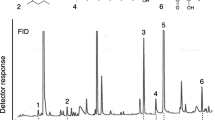Summary
The Neotropical ant Prionopelta amabilis, a cryptobiotic species in the phylogenetically primitive tribe Amblyoponini, lives in subterranean habitats, where it preys preferentially on campodeid diplurans and other small arthropods. Here we report that the species employs chemical recruitment and orientation trails during foraging and nest emigrations. The trail pheromone originates in a hitherto unknown basitarsal gland located in the basitarsus of the hindlegs. Trails are laid by a special foot dragging behavior. During the recruitment process the chemical trail signal is complemented by body shaking on the part of the recruiting ant. Foragers frequently wipe the basitarsal gland opening in the hindlegs with the grooming apparatus of the front legs. This latter structure is equipped with unusual glands evidently specialized for this purpose.
Similar content being viewed by others
References
Billen J (1984) Morphology of the tibial gland in the ant Crematogaster scutellaris. Naturwissenschaften 71:324–325
Billen J (1987) Morphology and ultrastructure of the exocrine glands in social Hymenoptera. In: Eder J, Rembold H (eds) Chemistry and biology of social insects. J. Peperny, München, 81–84
Brown WL (1960) Contribution toward a reclassification of the Formicidae, III: Tribe Amblyoponini (Hymenoptera). Bull Mus Comp Zool Harvard Univ 122:144–230
Burns MS, Bretschneider A (1981) Thin is in. American Society of Clinical Pathologists, Educational Products Division, Chicago
Fletcher DJC, Brand JM (1968) Source of the trail pheromone and method of trail laying in the ant Crematogaster peringueyi. J Insect Physiol 14:783–788
Hölldobler B (1982) Chemical communication in ants: New exocrine glands and their behavioral function. In: Breed MD, Michener CD, Evans HE (eds) The biology of social insects. Westview Press, Boulder, pp 312–317
Hölldobler B, Engel H (1978) Tergal and sternal glands in ants. Psyche (Cambridge, Mass) 85:285–330
Hölldobler B, Engel H (1982) Tergal and sternal glands in male ants. Psyche (Cambridge, Mass) 89:113–132
Hölldobler B, Palmer JM (1989a) A new tarsal gland in ants and the possible role in chemical communication. Naturwissenschaften 76:385–386
Hölldobler B, Palmer JM (1989b) Footprint glands in Amblyopone australis (Formicidae, Ponerinae). Psyche (Cambridge, Mass) 96:111–121
Hölldobler B, Wilson EO (1986) Ecology and behavior of the primitive cryptobiotic ant Prionopelta amabilis (Hymenoptera: Formicidae). Insectes Sociaux 33:45–58
Hölldobler B, Wilson EO (1990) The ants. Belknap Press of Harvard University Press, Cambridge (Mass) and Springer, Berlin Heidelberg
Hölldobler B, Engel H, Taylor RL (1982) A new sternal gland in ants and its function in chemical communication. Naturwissenschaften 69:90–91
Janet C (1894) Sur l'organe de nettoyage tibio-tarsien de Myrmica rubra L. race laevindis Nyl. Ann Soc Entomol Fr 63:691–704
Jessen K, Maschwitz U (1986) Orientation and recruitment behavior in the ponerine ant Pachycondyla tesserinoda (Emery): laying of individual-specific trails during tandem running. Behav Ecol Sociobiol 19:151–155
Jessen K, Maschwitz U, Hahn M (1979) Neue Abdominaldrüsen bei Ameisen. I. Ponerini (Formicidae: Ponerinae). Zoomorphologie 94:49–66
Leuthold RH (1968) A tibial gland scent-trail and trail-laying behavior in the ant Crematogaster ashmeadi Mayr. Psyche (Cambridge, Mass) 75:233–248
Pasteels JM, Crewe RM, Blum MS (1970) Étude histologique et examen au microscope électronique a balayage de la glande sécrétant la pheromone de piste chez deux Crematogaster norda-mericains (Formicidae: Myrmicinae). C R Acad Sci Paris 271D: 835–838
Schönitzer K, Dott H (1989) Eine Drüse als Bestandteil des tibiotarsalen Putzapparates der Ameise Messor rufitarsis (Hymenoptera: Formicidae). Verh Dtsch Zool Ges 82:191
Schönitzer K, Lawitzky G (1987) A phylogenetic study of the antenna cleaner in Formicidae, Mutillidae, and Tiphiidae (Insecta, Hymenoptera). Zoomorphology 107:271–285
Spurr AR (1969) A low viscosity epoxy resin embedding medium for electron microscopy. J Ultrastruct Res 26: 31–43
Whelden RM (1960) The anatomy of Rhytidoponera metallica F. Smith (Hymenoptera: Formicidae). Ann Entomol Soc Am 53:793–808
Author information
Authors and Affiliations
Rights and permissions
About this article
Cite this article
Hölldobler, B., Obermayer, M. & Wilson, E.O. Communication in the primitive cryptobiotic ant Prionopelta amabilis (Hymenoptera: Formicidae). J Comp Physiol A 171, 9–16 (1992). https://doi.org/10.1007/BF00195956
Accepted:
Issue Date:
DOI: https://doi.org/10.1007/BF00195956




